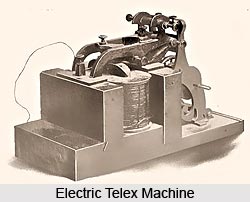 Development in Telegraph system took place in the mid nineteenth century. Telegraph communication was essential for effective and safe railway signalling. In 1851 telegraphs had been extended over 4,250 miles of India. This linked forty-six receiving stations. They were from Calcutta to Agra and the northwest. It connected Bombay, Madras and Ootacamund. There were around 17,500 miles of telegraph lines by 1865. By the end of the century it reached 52,900 miles. India`s 100,000 lines carried 17 million telegraphic messages a year by the early twentieth century.
Development in Telegraph system took place in the mid nineteenth century. Telegraph communication was essential for effective and safe railway signalling. In 1851 telegraphs had been extended over 4,250 miles of India. This linked forty-six receiving stations. They were from Calcutta to Agra and the northwest. It connected Bombay, Madras and Ootacamund. There were around 17,500 miles of telegraph lines by 1865. By the end of the century it reached 52,900 miles. India`s 100,000 lines carried 17 million telegraphic messages a year by the early twentieth century.
The telegraph rose directly from political imperatives. Telegraph system was basically a response to the need for a rapid and reliable system of information. These telegraph lines demonstrated their importance by carrying their authority`s early intimations of the up-country revolt in May 1857. This system was also adopted by Indian and European businessmen. By the early twentieth century the government officials and nationalist politicians was unable to function without telegrams. The telegraph system incorporated India into administrative and commercial network once submarine cables were completed between India and Britain in 1870.
There was also a personal interest involved in the rapid construction of the telegraph system in India in the 1850s. O`Shaughnessy had built a 21 mile long experimental line near Kolkata. This was protected from the effects of tropical heat and humidity by using thicker cables. He showed how electrical signals could be sent over long distances in India. The telegraph system was basically an imported technology. Local expertise and the political patronage that this imported technology had received speeded its adoption and adaptation to the local conditions.
This article is a stub. You can enrich by adding more information to it. Send your Write Up to content@indianetzone.com






































